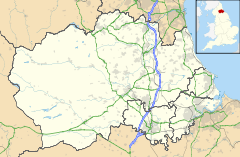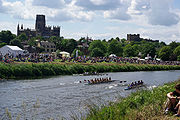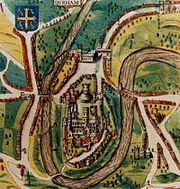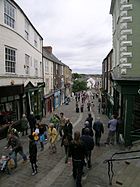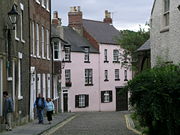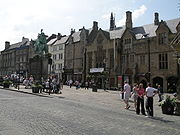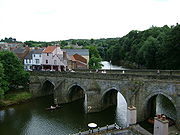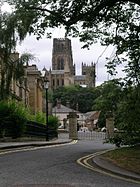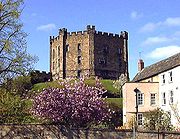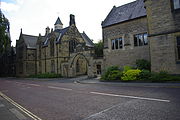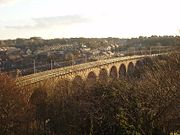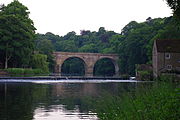
Durham
Background to the schools Wikipedia
Arranging a Wikipedia selection for schools in the developing world without internet was an initiative by SOS Children. Sponsoring children helps children in the developing world to learn too.
Coordinates: 54.7761°N 1.5733°W
| Durham | |
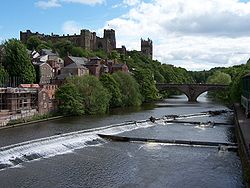 Durham Cathedral and the River Wear |
|
|
|
|
| Population | 29,091 (2001) |
|---|---|
| OS grid reference | NZ274424 |
| Unitary authority | County Durham |
| Ceremonial county | County Durham |
| Region | North East |
| Country | England |
| Sovereign state | United Kingdom |
| Post town | DURHAM |
| Postcode district | DH1 |
| Dialling code | 0191 |
| Police | Durham |
| Fire | County Durham and Darlington |
| Ambulance | North East |
| EU Parliament | North East England |
| UK Parliament | City of Durham |
|
|
Durham (pron.: / ˈ d ʌr əm /, locally / ˈ d ʊr əm /) is a city in the North East of England. It is within the County Durham local government district, and is the county town of the larger ceremonial county. It lies to the south of Newcastle Upon Tyne, Chester-le-Street and Sunderland and to the north of Darlington.
Durham is well known for its Norman Cathedral and 11th-century castle, and is home to Durham University. HM Prison Durham is also located close to the city centre.
Name
The name "Durham" comes from the Old English "dun", meaning hill, and the Old Norse "holme", which translates to island. The Lord Bishop of Durham takes a Latin variation of the city's name in his apostolic signature, which is signed "N. Dunelm." Some attribute the city's name to the legend of the Dun Cow and the milkmaid who in legend guided the monks of Lindisfarne carrying the body of Saint Cuthbert to the site of the present city in 995 AD. Dun Cow Lane is said to be one of the first streets in Durham, being directly to the east of Durham Cathedral and taking its name from a depiction of the city's founding etched in masonry on the south side of the cathedral. The city has been known by a number of names throughout history. The original Nordic Dun Holm was changed to Duresme by the Normans and was known in Latin as Dunelm. The modern form Durham came into use later in the city's history. The north eastern historian, Robert Surtees chronicled the name changes in his History and Antiquities of the County Palatine of Durham but states that it is an "impossibility" to tell when the city's modern name came into being.
History
Early history
Archeological evidence suggests a history of settlement in the area since roughly 2000 BC. The present city can clearly be traced back to AD 995, when a group of monks from Lindisfarne chose the strategic high peninsula as a place to settle with the body of Saint Cuthbert, that had previously lain in Chester-le-Street, founding a church there.
Legend of the Dun Cow and city origins
Local legend states that the city was founded in A.D. 995 by divine intervention. The 12th-century chronicler, Symeon of Durham, recounts that after wandering in the north, Saint Cuthbert’s bier miraculously came to a halt at the hill of Warden Law and, despite the effort of the congregation, would not move. Aldhun, Bishop of Chester-le-Street and leader of the order, decreed a holy fast of three days, accompanied by prayers to the saint. Saint Bede recounts that during this fast, Saint Cuthbert appeared to the monk Eadmer with instructions that the coffin should be taken to Dun Holm.
After Eadmer’s revelation, Aldhun found that he was able to move the bier, but did not know where Dun Holm was. By chance later that day, the monks came across a milkmaid at Mount Joy (southeast of present-day Durham). She stated that she was seeking her lost dun cow, which she had last seen at Dun Holm. The monks, realising that this was a sign from the saint, followed her. They settled at a "wooded hill-island formed by a tight gorge-like meander of the River Wear." After arriving at their destination, they erected the vestiges of Durham Cathedral, which was a "modest building." Symeon states that this was the first building in the city and, unfortunately, does not remain today having been supplanted by the Norman structure.
Medieval history
During the medieval period the city found spiritual prominence because it was the final resting place of Saint Cuthbert and Saint Bede the Venerable. Before the Reformation the shrine of Saint Cuthbert, situated behind the High Altar of Durham Cathedral, was the most important religious site in England until the martyrdom of St Thomas Becket at Canterbury.
Saint Cuthbert was famed for two reasons: Firstly, the miraculous healing powers he had displayed in life extended into death with many stories of those visiting the saint’s shrine being cured of all manner of diseases. This led to him being known as the "wonder worker of England". Secondly, after the first translation of his relics in 698 AD, his body was found to be incorruptible. Despite a brief translation back to Holy Island during the Norman Invasion the saint's relics remain enshrined to the present day. Saint Bede's bones are also entombed in the cathedral, drawing the mediaeval pilgrim to the city.
Durham’s geographical position has always given it an important position in the defence of England against the Scots. The city has played an important part in the defence of the north and Durham Castle is the only Norman castle keep never to have suffered a breach. The Battle of Neville's Cross which took place near the city on 17 October 1346 between the English and Scots is the most famous battle of the age.
The city suffered from a number of plague outbreaks in 1544, 1589 and 1598.
Prince Bishops
Owing to divine providence of the city’s founding, the Bishop of Durham has always enjoyed the title “Bishop by Divine Providence” opposed to all other bishops who are “Bishop by Divine Right”. However, as the north east was so far from Westminster the bishops of Durham enjoyed extraordinary powers such as the ability to hold their own parliament, raise their own armies, appoint their own sheriffs and Justices, administer their own laws, levy taxes and customs duties, create fairs and markets, issue charters, salvage shipwrecks, collect revenue from mines, administer the forests and mint their own coins. So far reaching were the bishop’s powers that the steward of Bishop Anthony Bek commented in 1299 AD: “There are two kings in England, namely the Lord King of England, wearing a crown in sign of his regality and the Lord Bishop of Durham wearing a mitre in place of a crown, in sign of his regality in the diocese of Durham” All this activity was administrated from the castle and buildings surrounding the Palace Green. Many of the original buildings associated with these functions of the County Palatine are still to be found on the peninsula.
Every Bishop of Durham from 1071 to 1836 was a Prince Bishop except for the first Norman-appointed Bishop Walcher who was styled an Earl-Bishop. Although the term prince bishop has been used as a helpful tool in the understanding the functions of the Bishops of Durham it is not a title they would have recognised. The last Prince Bishop of Durham Bishop William Van Mildert credited with the foundation of Durham University. Henry VIII curtailed some of the Prince-Bishop's powers and, in 1538, ordered the destruction of the shrine of Saint Cuthbert.
Legal System
The Prince Bishops also had their own court system, most notably the Durham Court of Chancery. The county also had its own attorney general, whose authority to bring an indictment for criminal matters was tested by central government in the infamous case of Rex v. Mary Ann Cotton (1832). The courts and judicial posts for the county were curtailed by the Law Terms Act 1830 and finally abolished by the Supreme Court of Judicature Act 1873.
Civil War and Commonwealth (1640 to 1660)
The city remained loyal to King Charles I throughout the English Civil War. Charles I came to Durham two times during his reign. Firstly, he came to the cathedral for a majestic service in which he was entertained by the Chapter and Bishop at great expense at the start of his reign. His second visitation to the city came towards the end of the Civil War, escaping from the city as Oliver Cromwell’s forces got closer. Local legend stated he escaped down the The Bailey and through Old Elvet. Another local legend has it that Cromwell stayed in a room in the present Royal County Hotel on Old Elvet during the Civil War. The room is reputed to be haunted by his ghost. Durham suffered greatly during the Civil War and Commonwealth. This was not due to direct assault by Cromwell but the abolition of the Church of England and the closure of religious institutions pertaining to it. The city has always relied upon the Dean and Chapter and cathedral as an economic force.
The castle suffered considerable damage and dilapidation during the Commonwealth due to the abolition of the office of bishop whose residence it was. Cromwell confiscated the castle and sold it to the Mayor of London shortly after taking it from the bishop. A similar fate befell the Cathedral, it being closed in 1650 and used to incarcerate 3,000 Scottish prisoners. Graffiti left by them can still be seen today etched into the interior stone.
At the Restoration in 1660, John Cosin (a former Canon) was appointed bishop and set about a major restoration project. This included the commissioning of the famous elaborate woodwork in the cathedral choir, the font cover, and the Black Staircase in the castle. Other renovations were carried out to both the city and cathedral by his successor Bishop Lord Nathaniel Crewe.
Eighteenth century
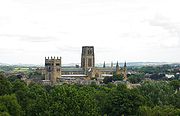
In 1720 it was proposed that Durham could become a sea port by digging a canal north to join the River Team, a tributary of the River Tyne near Gateshead. Nothing came of the plan, but the statue of Neptune in the Market Place was a constant reminder of Durham's maritime possibilities.
The thought of ships docking at the Sands or Millburngate remained fresh in the minds of Durham businessmen. In 1759, a new proposal hoped to make the Wear navigable from Durham to Sunderland by altering the river's course, but the increasing size of ships made this impractical. This was further compounded by the fact Newcastle upon Tyne had grown as the north east's main port and centre for shipping.
The eighteenth century also saw the rise of the trade union movement in the city.
Nineteenth century
The Great Reform Act, 1832 saw the removal of the Prince Bishop’s powers, although he still has the right to a seat in the House of Lords and is regarded as the third most senior bishop in the Church of England. The Court of Claims of 1953 granted the traditional right of the bishop to accompany the sovereign at the coronation, reflecting his seniority.
The first census, conducted in 1801, states that Durham City had a population of 7,100. The Industrial Revolution mostly passed the city by. However, the city was well-known for carpet making and weaving. Although most of the mediaeval weavers who thrived in the city had left by the nineteenth century, the city was the home of Hugh MacKay Carpets’ factory, which produced the famous brands of axminster and tufted carpets until the factory was forced into administration in April 2005. Other important industries were the manufacture of mustard and coal extraction.
The Industrial Revolution also placed the city at the heart of the coal fields, the county’s main industry until the 1970s. Practically every village around the city boasted a coal mine and, although these have since disappeared as part of the regional decline in heavy industry, the proud traditions, heritage and community spirit are still evident. The city also saw the creation of the world’s first passenger railway in 1825.
The nineteenth century also saw the founding of Durham University thanks to the benevolence of Bishop William Van Mildert and the Chapter in 1832. Durham Castle became the first college ( University College, Durham) and the Bishop moved to Auckland Castle as his only residence in the county.
The first Durham Miners' Gala was held in 1871 and remains the largest socialist trade union event in the world.
Geography
General geography
Durham is situated 13 miles (21 km) to the south west of Sunderland, England. The River Wear flows north through the city, making an incised meander which encloses the centre on three sides to form Durham's peninsula. At the base of the peninsula is the Market Place, which still hosts regular markets; a permanent indoor market is also situated just off the Market Place. The Market Place and surrounding streets are one of the main commercial and shopping areas of the city. From the Market Place, The Bailey leads south past Palace Green; The Bailey is almost entirely owned and occupied by the university and the cathedral.
Durham is a hilly city, claiming to be built upon the symbolic seven hills. Upon the most central and prominent position high above the Wear, the cathedral dominates the skyline. The steep riverbanks are densely wooded, adding to the picturesque beauty of the city. West of the city centre, another river, the River Browney, drains south to join the Wear to the south of the city.
The county town of County Durham, until 2009 Durham was located in the City of Durham local government district, which extended beyond the city, and had a total population of 87,656 in 2001, covering 186.68 square kilometres in 2007. In 2001, the unparished area of Durham had a population of 29,091, whilst the built-up area of Durham had a population of 42,939.
There are three old roads out of the Market Place: Saddler Street heads south-east, towards Elvet Bridge, The Bailey and Prebends Bridge. Elvet Bridge leads to the Elvet area of the city, Durham Prison and the South; Prebends Bridge is smaller and provides access from The Bailey to South Durham. Heading west, Silver Street leads out of the Market Place towards Framwellgate Bridge and North Road, the other main shopping area of the city. From here, the city spreads out into the Framwelgate, Crossgate, Neville's Cross and viaduct districts, the other main shopping area of the city. Beyond the viaduct lie the outlying districts of Framwellgate Moor and Neville's Cross. Heading north from the Market Place leads to Claypath. The road curves back round to the east and beyond it lie Gilesgate, Gilesgate Moor and Dragonville.
Many of the inner city areas are now inhabited by students living in shared houses. In some roads as many as 70% of the dwellings are occupied by students.
Historical geography
The historical city centre of Durham has changed little over the past 200 years. It is made up of the peninsula containing the cathedral, palace green, former administrative buildings for the palatine and Durham Castle. This was a strategic defensive decision by the city's founders and gives the cathedral a striking position. So much so that Symeon of Durham stated:
"To see Durham is to see the English Sion and by doing so one may save oneself a trip to Jerusalem"
Sir Walter Scott was so inspired by the view of the cathedral from South Street that he wrote "Harold the Dauntless", a poem about Saxons and Vikings set in County Durham and published on 30 January 1817. The following lines from the poem are carved into a stone tablet on Prebends Bridge:
Grey towers of Durham
Yet well I love thy mixed and massive piles
Half church of God, half castle 'gainst the Scot
And long to roam those venerable aisles
With records stored of deeds long since forgot.
The old commercial section of the city encompasses the peninsula on three sides, following the River Wear. The peninsula was historically surrounded by the castle wall extending from the castle keep and broken by two gatehouses to the north and west of the enclosure. After extensive remodelling and "much beautification" by the Victorians the walls were removed with the exception of the gatehouse which is still standing on The Bailey.
The medieval city was made up of the cathedral, castle and administrative buildings on the peninsula. The outlying areas were known as the townships and owned by the bishop, the most famous of these being Gilesgate (which still contains the mediaeval St Giles Church), Claypath and Elvet.
The outlying commercial section of the city, especially around the North Road area, saw much change in the 1960s during a redevelopment spearheaded by Durham City Council, however, much of the original mediaeval street plan remains intact in the area close to the cathedral and market place. Most of the mediaeval buildings in the commercial area of the city have disappeared apart from the House of Correction and the Chapel of Saint Andrew, both under Elvet Bridge. Georgian buildings can still be found on the Bailey and Old Elvet most of which make up the colleges of Durham University.
Climate
The table below gives the average temperature and rainfall figures taken between 1971 and 2000 at the Met Office weather station in Durham:
|
||||||||||||||||||||||||||||||||||||||||||||||||||||||||||||||||||||||||||||||||||||||||||||||||||||||||||||||||||||||||||||||||||||||||||||
Like the rest of the United Kingdom, Durham has a temperate climate. At 643.3 millimetres (25 in) the average annual rainfall is lower than the national average of 1,125 millimetres (44 in). Equally there are only around 121.3 days where more than 1 millimetre (0.04 in) of rain falls compared with a national average of 154.4 days. The area sees on average 1374.6 hours of sunshine per year, compared with a national average of 1125.0 hours. There is an air frost on 52 days compared with a national average of 55.6 days. Average daily maximum and minimum temperatures are 12.5 °C (54.5 °F) and 5.2 °C (41.4 °F) compared with a national averages of 12.1 °C (53.8 °F) and 5.1 °C (41.2 °F) respectively.
Governance
The ancient borough covering Durham was Durham and Framwelgate and it was reformed by the Municipal Corporations Act 1835. In 1974 it was merged with Durham Rural District and Brandon and Byshottles Urban District to form the City of Durham district of County Durham. The district was abolished in 2009 with its responsibilities assumed by Durham County Council, a unitary authority. Since April 2009 city status has been held by charter trustees for the area of the former district. Durham's MP is Roberta Blackman-Woods (Labour).
Economy
This is a table of trend of regional gross value added of County Durham at current basic prices published (pp. 240–253) by Office for National Statistics with figures in millions of British Pounds Sterling.
| Year | Regional Gross Value Added | Agriculture | Industry | Services |
|---|---|---|---|---|
| 1995 | 4,063 | 47 | 1,755 | 2,261 |
| 2000 | 4,783 | 40 | 1,840 | 2,904 |
| 2003 | 5,314 | 39 | 1,978 | 3,297 |
Landmarks
The whole of the centre of Durham is designated a conservation area. The conservation area was first designated on 9 August 1968, and was extended on 25 November 1980. In addition to the Cathedral and Castle, Durham contains over 630 listed buildings, 569 of which are located within the city centre conservation area. Particularly notable properties include:
Grade I listed
- Chorister School
- Crook Hall
- Durham Castle
- Durham Cathedral
- Elvet Bridge
- Framwellgate Bridge
- Kepier Hospital
- Kingsgate Bridge
- Prebends Bridge
- St Giles Church, Gilesgate
- Church of St Margaret of Antioch, Crossgate
- Church of St Mary-le-Bow (now Durham Heritage Centre)
- St. John's College Chapel, formerly the Church of St Mary the Less
- St. John's College, Linton House, 1 South Bailey
Grade II* listed
- Aykley Heads House (now Bistro 21)
- Bishop Cosin's Hall, Palace Green
- Cosin's Library (now part of University Library, Palace Green)
- Crown Court, Old Elvet
- St Cuthbert's Society, 12 South Bailey
- St John's College, 3 South Bailey
- St Oswald's Church
- Railway viaduct, North Road
- Town Hall and Guildhall, Market Place
Grade II listed
- Durham Observatory
- The Chapel of the College of St Hild and St Bede
Durham Cathedral
The Cathedral Church of Christ, Blessed Mary the Virgin and St Cuthbert of Durham, commonly referred to as Durham Cathedral was founded in its present form in AD 1093 and remains a centre for Christian worship today. It is generally regarded as one of the finest Romanesque cathedrals in Europe and the rib vaulting in the nave marks the beginning of Gothic ecclesiastical architecture. The cathedral has been designated a UNESCO World Heritage Site along with nearby Durham Castle, which faces it across Palace Green, high above the River Wear.
The Cathedral houses the shrine and related treasures of Cuthbert of Lindisfarne, and these are on public view. It is also home to the head of St Oswald of Northumbria and the remains of the Venerable Bede.
Durham Castle
The castle was originally built in the eleventh century as a projection of the Norman power in the north of England, as the population of England in the north remained rebellious following the disruption of the Norman Conquest in 1066. It is an excellent example of the early motte and bailey castles favoured by the Normans. The holder of the office of Bishop of Durham was appointed by the King to exercise royal authority on his behalf and the castle was the centre of his command.
It remained the Bishop's palace for the Bishops of Durham until the Bishop William Van Mildert made Bishop Auckland their primary residence. A founder of Durham University, Van Mildert gave the castle as accommodation for the institution's first college, University College. The castle was famed for its vast Great Hall, created by Bishop Antony Bek in the early fourteenth century. It was the largest Great Hall in Britain until Bishop Richard Foxe shortened it at the end of the Fifteenth century . However, it is still 14 m high and over 30 m long. The castle is still the home of University College, Durham (which is, as a result, known informally as "Castle"). It has been in continuous use for over 900 years and is the only castle in the United Kingdom never to have suffered a breach.
Education
The University of Durham
Durham is home to Durham University. It was founded as the University of Durham (which remains its official and legal name) by Act of Parliament in 1832 and granted a Royal Charter in 1837. It was one of the first universities to open in England for more than 600 years, and is claimed to be England's third oldest after Oxford and Cambridge (although other higher education institutions also make this claim – see third oldest university in England debate).
Further education
New College Durham is the city's largest college of further, higher and Sixth Form education. It was founded in 1977 as a result of a merger between Neville's Cross College of Education and Durham Technical College. The college operated on two main sites near the city of Durham: Neville's Cross and Framwellgate Moor. The site at Framwellgate Moor opened in 1957 and has subsequently been rebuilt. The Neville's Cross Centre, which used to be housed in the county's former asylum has been sold for development into houses.
Schools
The results relate to the 2008 examination series.
Secondary schools
Durham is served by five state secondary schools:
| School | GCSE Results (percentage A* to C) | A/AS Average points |
|---|---|---|
| Belmont School Community and Arts College | 48% | N/A |
| Durham Gilesgate Sports College + 6th Form Centre | 26% | 766.1 |
| Durham Johnston Comprehensive School | 73% | 853.1 |
| Framwellgate School Durham | 77% | 645.8 |
| St Leonard's Roman Catholic school | 65% | 751 |
Independent schools
There are three independent schools:
| School | GCSE Results (percentage A* to C) | A/AS Average points |
|---|---|---|
| The Chorister School | N/A | N/A |
| Durham High School for Girls | 98% | 854.8 |
| Durham School | 76% | 807.1 |
Primary schools
Primary schools include:
- Finchale Primary School
- Durham Blue Coat Junior School
- Durham Gilesgate Primary
- St Joseph's RCVA Primary
- St Margaret's CofE Primary School
- St Oswald's CofE Infant School
- Brandon Primary School
- Nevilles Cross Primary School
- St.Godric's RC.V.A. Primary School
Transport
Durham railway station is situated on the East Coast Main Line between Edinburgh and London; rail travellers coming from the south enter Durham over a spectacular Victorian viaduct high above the city. By road, the A1(M), the modern incarnation of the ancient Great North Road, passes just to the east of the city. (Its previous incarnation, now numbered A167, passes just to the west.) Newcastle Airport lies to the north, and Durham Tees Valley Airport to the south, both being about 25 miles (40 km) away. The Market Place and peninsula form the UK's first (albeit small) congestion charging area, introduced in 2002.
A park and ride service is also available.
Sport
Cricket
Durham City Cricket Club plays on its own ground near the River Wear:
Formed in 1829, Durham City was one of the founder members of the Durham Senior Cricket League upon its creation in 1903 and the First XI have been crowned champions on thirteen occasions.
Football
The town's football club Durham City A.F.C. once boasted membership of the Football League between 1921 and 1928 but has long been a non-league club. The 2008/09 season will see them make a step up the pyramid to play in the Unibond League. Their home ground is New Ferens Park, known as The Arnott Stadium for sponsorship reasons.
Ice rink
Durham Ice Rink was a central feature of the city for some 60 years until it closed in 1996 and was home to the Durham Wasps team. There are plans to open a new rink in the city.
Rifle shooting
The St Giles Yarner Rifle Club shoots at an indoor range in the city.
Rowing
The River Wear provides some 1800m of river that can be rowed on, stretching from Old Durham Beck in the east ( 54°46′21.49″N 1°33′26.75″W) to the weir next to Durham School Boat Club's boat house in the west ( 54°46′20.95″N 1°34′45.35″W). This includes the 700m straight used for most of the Durham Regatta races and some challenging navigation through the arches of Elvet Bridge, reputed to be the narrowest row through bridge in Europe, and the bends of the river round the peninsula. There is a path running alongside the river's south bank (i.e. the Cathedral side) for the entire length of the stretch available for rowing, the concrete section between Hatfield College boathouse and Elvet Bridge being completed in 1882.
For sport rowing there is a number of boat clubs operating on this stretch, Durham Amateur Rowing Club, the Durham University Boat Club, the 14 university college clubs of the Durham campus, Durham Constabulary and the school clubs – Durham School Boat Club and St Leonard's who row regularly in their own colours out of their own boat houses and Durham High School for Girls who may row out of Durham Amateur Rowing Club.
Durham Amateur Rowing Club
Durham Amateur Rowing Club, DARC, operates out of a purpose built community clubhouse on the River Wear which opened in 2007:
Durham Amateur Rowing Club is one of the country's oldest clubs (founded in 1860) and lies at the end of Green Lane in Durham, occupying a tranquil setting on the River Wear.
The club takes part in the government scheme playing for success where it uses sport to combine rowing, science, computers and video to help boost literacy and numeracy.
Durham University rowing
Durham University rowing is divided into two sections: Durham University Boat Club and Durham College Rowing, the latter comprises 16 college boat clubs. For more information see their pages.
Regattas and head races
The River Wear is host to a number of regattas and head races throughout the year. These include:
the Novice Cup, Wear Long Distance Sculls, and Senate Cup in November and December; Durham Small Boats Head in February; Durham City Regatta in May; Durham Regatta and Admirals Regatta in June; and Durham Primary Regatta in September.
Durham Regatta
Durham Regatta has been held on the River Wear in Durham since 1834. It is the second oldest regatta in Britain and is often referred to as 'the Henley of the North'.
Durham Regatta in its current form dates back to 1834, when only a handful of trophies were competed for over a period of three days. Today, the Regatta takes place over a period of two days, at which dozens of trophies are competed for. It is a favourite amongst Durham University, Durham School and Durham Amateur Rowing Club, who have competed regularly since the early days.
Pleasure boats
In addition to the competitive rowing and sculling of the boat clubs mentioned above, there is also a thriving hire of public pleasure boats from April to October.
Rugby
Durham City Rugby Club has its headquarters on Green Lane:
Durham City R.F.C., the second oldest club in the County, was founded in 1872 with navy and gold playing colours and Durham Cathedral's Sanctuary Knocker as the club’s crest.City have a proud heritage and there Hollow Drift home has been developed into an excellent rugby facility which includes two floodlit pitches and a training area.
At present, City run four senior sides, a Veteran’s XV, a Ladies XV and mini and junior teams from aged 6 to 17.
University Sport
The university has a major sporting impact on the City, for more details see University Sport.
Notable people
- Gem Archer (born 1966), guitarist with the band Oasis
- Rowan Atkinson, (born in Consett in 1955), actor. Attended the Chorister School 1964–1966.
- Pat Barker, (born in Thornaby on Tees in 1943), novelist ('Regeneration' trilogy), now resident in Durham.
- Barnabe Barnes, (baptised 1571, died 1609), Elizabethan poet. Died in Durham.
- Tony Blair, (born 1953) former Prime Minister of the United Kingdom. Attended the Chorister School 1961–1966.
- Count Joseph Boruwlaski (1739–1837), celebrated dwarf, spent last years of his life in Durham.
- Rev. Edward Bradley (1827–1889). Studied at Durham University and took his nom de plume "Cuthbert Bede" from the names of two its colleges.
- Richard Caddel (1949–2003), poet. Lived in Durham from the 1970s and was co-director of the Basil Bunting poetry centre at Durham University library from 1988.
- George Camsell (1902–1966), international footballer, born in Framwellgate Moor.
- Paul Collingwood (born 1976), international cricketer. Born in Shotley Bridge, now resident in Durham.
- Sir Kingsley Dunham (1910–2001), Professor of Geology and later Professor Emeritus at the University of Durham, director of the British Geological Survey from 1967–75.
- John Bacchus Dykes (1823–1876), hymnologist, clergyman in Durham from 1849 to his death.
- John Meade Falkner (1858–1932), arms manufacturer and novelist. Lived in Durham from 1902, and became Honorary Reader in Paleography at the University of Durham, and Honorary Librarian to the Dean and Chapter Library of Durham Cathedral.
- James Fenton (born 1949), journalist and poet. Attended the Chorister School 1957–1962.
- Max Ferguson (born 1924), Canadian broadcaster, born in Durham.
- John Garth (1721–1810), composer. Lived in Durham for much of his life.
- Godric of Finchale (c. 1065–1170), popular medieval saint, briefly served as doorkeeper at St Giles Hospital in Durham before becoming a hermit.
- Andy Gomarsall (born 1974), International Rugby union player. Born in Durham.
- John Gully (1783–1863), prize fighter, racehorse owner and politician. Resident in Durham at time of his death.
- Warren Hawke, professional footballer
- Ian Hay, novelist (taught at Durham School)
- Trevor Horn, record producer and member of The Buggles and Art Of Noise, born in Durham 1949.
- Steve Howard, professional footballer
- Violet Hunt, novelist
- Paddy McAloon, musician, born in Durham in 1957
- Liam Rhys Jones, musician, opera singer, Winner of BBC2's Young Chorister of the Year 2010
- Cyril Edwin Mitchinson Joad, philosopher and radio broadcaster
- Stephen Kemble of the famous British acting family, the Kemble family lived, worked and is buried in Durham.
- Lawrence of Durham, poet
- Sir John Grant McKenzie Laws, Lord Justice Laws, judge (attended the Chorister School)
- Thomas Morton, playwright.
- Graeme Nicholls, guitarist
- Stuart Parnaby, Birmingham City F.C footballer, born 1982 in Durham.
- William Pearson, watercolorist and topographer
- Anna Maria Porter, novelist
- Jane Porter, novelist
- Michael Ramsey, 100th Archbishop of Canterbury (once Bishop of Durham)
- Reginald of Durham, hagiographer
- Gordon Scurfield, biologist and author
- Peter Shoulder, musician, vocalist and guitarist of Winterville & The Union
- Christopher Smart, poet
- Joseph Spence, literary memoirist
- Anne Stevenson, Poet
- Mary Stewart (novelist and poet), born in Sunderland, graduated from Durham University and was a lecturer there in English Literature (author of 20 novels, including The Moonspinners, Madam Will You Talk, and the Merlin trilogy)
- Robert Surtees, historian and antiquarian
- Symeon of Durham, historian
- Sir Peter Vardy, businessman (attended the Chorister School)
- Hugh Walpole, novelist
- Walter of Durham, 13th century painter
- Sir Arnold Wolfendale, Astronomer Royal
- James Wood, literary critic
Twin towns
 Department of the Somme, (France)
Department of the Somme, (France)
